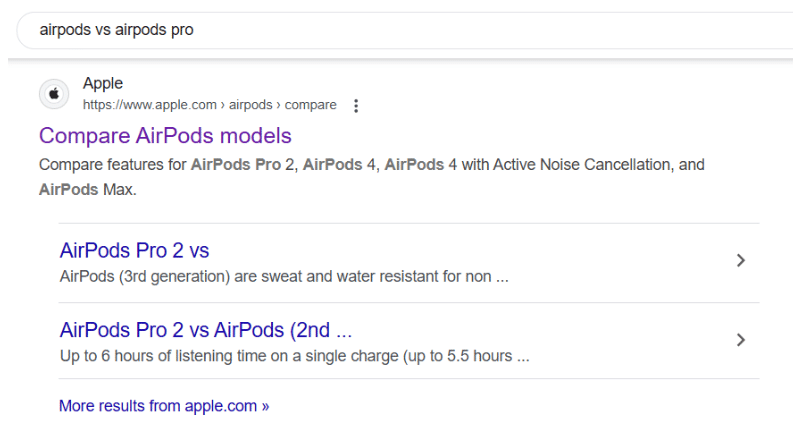It’s not news that generative AI is rapidly shifting the traditional SEO landscape that we knew a few years back. Since the introduction of Google’s AI Overviews last May, we have witnessed a significant change in how organic information is presented to users.
While the impact of AI Overviews on search was expected, our predictions about how they would affect traffic has evolved.
Early on, SEO experts assumed AI Overviews –mainly appearing for informational queries– would primarily affect top-of-funnel traffic, with little impact on mid- to bottom-funnel, conversion-driven pages.
However, recent search updates suggest that initial prediction might not hold up. One trend we’re seeing is the increasing presence of product and service comparisons directly within AI-generated summaries, capturing traffic from more conversion-focused searches. So what does that mean for your SEO strategy? Let’s dive in.
Understanding AI Overviews and Comparison Features
AI Overviews, launched by Google in May 2024, provide direct answers to search queries at the top of search results pages. These answer summaries are generated using generative AI and often include a list of web sources.
AI Overview Example

From Informational to Transactional Queries
Initially, AI Overviews were mainly showing up for informational queries, leading many marketers to believe, as outlined in this Digital Marketing Institute article, that only informational or top-funnel traffic would be impacted.
However, in February 2025, Google began rolling out product comparisons in AI Overviews. These comparisons now appear for more transactional, mid- to bottom-funnel searches from users looking for more information before making a purchase.
Example: “AirPods vs AirPods Pro” in AI Overviews
For instance, when you search “airpods vs airpods pro,” a product comparison AI Overview now appears. Before expanding the dropdown, the AI Overview displays product images, pricing, reviews, and a brief summary of key comparison points like battery life, noise cancellation, and design.
“Airpods vs airpods pro” Default AI Overview

When you click the dropdown to view the full AI Overview, there is an expansive product comparison table that breaks down specific features like connectivity, sound quality, and fit.
“Airpods vs airpods pro” Expanded AI Overview

These summaries are clearly geared toward conversions, giving users just enough context to make a purchase decision without needing to visit individual product pages. This shift highlights a broader trend of AI Overviews moving deeper into the conversion journey.
4 Key Takeaways from Comparison AI Overviews
To better understand how this impacts your strategy, here are four key takeaways from Google’s rollout of product comparison AI Overviews:
1. AI Overviews Are Targeting Conversion-Intent Traffic
Google’s shift toward serving product comparisons within AI Overviews indicates a stronger focus on transactional intent. That means pages optimized for mid-funnel and bottom-funnel queries are now more likely to be affected by AI summaries, especially for searches that include “vs,” “best,” or specific product attributes.
2. Comparison AI Overviews Appear Lower on the Page
Unlike standard AI Overviews, which often appear directly beneath the search bar, comparison-based Overviews tend to appear further down the results page. This suggests that Google is testing different placements for different query types. While lower placement might reduce visibility slightly, these Overviews still draw significant attention, especially with the inclusion of images and product data.
3. Third-Party Sellers Are Featured Over Official Brand Sites
Another notable shift is the inclusion of third-party sellers within the AI Overview itself. In some examples, like the “airpods vs airpods pro” AI Overview, the summary links directly to e-commerce retailers rather than brand websites.
Third-Party Seller Listed for “airpods vs airpods pro” AI Overview

This creates new opportunities, and competition, for retailers and affiliate marketers. Most importantly, it also means that brands will have to optimize their content to ensure that their website is featured.
4. Other Comparison Pages May Rank Ahead of AI Overviews
Even though Apple isn’t featured as the primary seller within the AI Overview, its official AirPods comparison page still holds the #1 organic position and appears above the AI Overview.
First Search Results Page for “airpods vs airpods pro”

This shows that well-optimized, authoritative comparison pages can still outrank AI-generated content in some cases. It also reinforces the importance of creating helpful, structured comparison content that aligns closely with search intent.
Based on these trends, there are several tactics websites can use to: 1) increase the chances of their products being featured in Comparison AI Overviews, and 2) help their comparison content rank above the AI Overview itself.
Adapting Your Strategy to Comparison AI Overviews
To stay visible within AI Overview summaries, brands will need to shift how they approach product content, especially when it comes to comparison-focused queries.
Here’s how to adapt your content strategy to better align with how AI Overviews are surfacing product comparisons:
Create product comparison pages that can outrank AI Overviews
Comparison pages are dedicated landing or blog pages designed to evaluate and contrast products, services, or brands. The most effective ones include structured tables comparing product features like price, material, and functionality, as well as customer reviews and FAQ sections to address buyer concerns.
There are several types of comparison pages you can create:
- Brand vs. Brand pages that compare competitors head-to-head
- Product vs. Product pages that go in-depth on two specific models
- Attribute vs. Attribute pages that evaluate features like color, size, or material
Conduct keyword research in your industry to identify which comparison-related searches trigger a comparison AI Overview in the results. Prioritize creating content that targets those keywords, then proactively build additional comparison pages to maintain brand visibility in the search results and drive users to your site.
Include comparison keywords like “vs” and “alternative” in your headings and title tags for comparison content.
These terms signal to both users and search engines that your content directly addresses comparison intent. Structuring your content this way increases the likelihood of being considered for AI Overviews targeting side-by-side evaluations.
Use clear, structured comparison tables or bullet points that highlight key product features.
Tables and bullet points that clearly break down product features (like price, specs, pros/cons, and use cases) are more likely to be pulled into AI-generated content and increase user engagement. Make sure that the table includes actual text, and is not an image. Otherwise, crawlers will not be able to read the text.
Add Product, Review, and FAQ schema to help AI understand your content.
Schema markup gives Google additional context about your content. For comparison-focused pages, this can improve your chances of showing up as a cited source or even being linked from within the AI Overview.
Make pricing, specs, and differentiators short and to the point.
Keep product data up-to-date and clearly labeled, while using minimal text. The easier your content is to process, the more likely it will be used in AI-generated answers.
Ensure your product pages are consistent across platforms like Amazon, Walmart, or other retailers where Google may pull data.
Because AI Overviews often reference third-party sellers, it’s important that your brand presence is strong and product information is accurate across all major marketplaces. Consistent descriptions, imagery, and reviews help reinforce your authority and improve your visibility.
Conclusion
The inclusion of product comparison tables in AI Overviews shows that generative AI is expanding beyond top-of-funnel, informational queries and starting to capture more conversion-oriented traffic. It’s important for brands to recognize this shift and take action to protect and grow their organic revenue. By building and optimizing dedicated comparison pages, brands can better compete with AI Overviews and increase their chances of being featured as a source or seller within them.
Let Fire&Spark help you adapt to generative AI search…
- Schedule an SEO strategy session: Talk to a strategist at Fire&Spark about your organic customer acquisition campaigns and how to reposition your existing strategy for generative AI search. Schedule a strategy session.
- Dive deeper into SEO for Revenue: Fire&Spark’s SEO for Revenue Guide explains how to update your SEO strategies to optimize for sales and conversions, not just rankings and traffic. This mindset shift is crucial for adapting to generative AI search. Get the guide.
- Request a generative AI search audit: Our team would be happy to take a look at your site and help you forecast the effect of generative AI search and Google’s AI overviews on your organic traffic. Request an audit.

